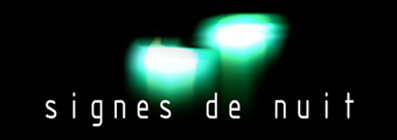6ème Festival Signes de Nuit
Selection de la Video Art hongroise
Fondation Suisse / Cité universitaire
7k, bd. Jourdan
75014 Paris
Samedi 5 April 2008
18 h 10
De Occulta Philosophia , de Gábor Bódy * (1946-1985) (Hongrie - Hungary / 1983 / DV / 0:13:00)
Eurynome tánca, de Gábor Bódy (Hongrie - Hungary / 1985 / DV / 0:03:00)
Walzer , de Gábor Bódy (Hongrie / 1985 / DV / 0:03:00)
OCD (brain), de Tamás Komoróczky** (1963-) (Hongrie - Hungary / 2001 / DV / 0:01:00)
OCD (bonus), de Tamás Komoróczky (Hongrie - Hungary / 2001 / DV / 0:03:00)
NataSsa, d’Hajnal Németh (1972-) (Hongrie - Hungary / 2000 / DV / 0:01:30)
Bar24, Hajnal Németh (Hongrie - Hungary / 2003 / DV / 0:04:00)
Gogo 01, Hajnal Németh (Hongrie - Hungary / 2004 / DV / 0:05:00)
Do You Know My Method?, de János Sugár *** (1958-) (Hongrie - Hungary / 2002 / DV / 0:08:00)
Rever, Szabolcs KissPál (1967-) (Hongrie - Hungary / 2001 / DV / 0:03:00)
Edging, Szabolcs KissPál (Hongrie - Hungary / 2003 / DV / 0:03:00)
The garden of the blind, Szabolcs KissPál (Hongrie - Hungary / 2005 / DV / 0:03:45)
Don‘t help me, Julia Vécsei (Hongrie - Hungary / 2002 / Flash-application / 0:05:00)
Home Video, d’Ádám Lendvai (Hongrie - Hungary / 2000 / DV / 0:05:00)
Layers, d’Ádám Lendvai (Hongrie - Hungary / 2005 / DV / 0:05:00)
* Gábor Bódy (1946–1985)
Bódy is one of the best known Hungarian filmdirectors in an international context. In 1972 he took his degree in philosophy and was then admitted to the Academy of Theatre and Film Art in Budapest and the same year made his first experimental film. From 1975 onwards his films received him international recognition including several festival prizes for his feature films, which like Narcissus and Psyche (1980) and The Dog’s Night Song (1983). Bódy lived mostly abroad from 1982 onwards, mainly in West Berlin. He understood the significance of video art from the early 1980s he became a leading figure on the international video–art scene. He was the founder of Infermental, a video art magazine on VHS tapes. Besides making feature films he kept producing video works and one of his aims was to produce „philo–liro– mitho–clips“.
A Triptych consisting of three three-minute tapes that expresses three different aspects of Bódy's artistic aspirations.
Philo-Clip is inspired by De Occulta Philosophia, a magic manual written by Agrippa von Nettesheim, the 15th century occult adept. Bódy depicts an outline of the relations of the human body which is combined with elliptical light signals that pulsate and are driven by synthetic bursts of sound. A figure appears. The alchemist, who was once von Nettesheim, now finds his expression in and through Bódy.
Mytho-Clip – Dancing Eurynome (1983). Mytho-Clip is dedicated to the Greek Goddess Eurynome, the child of Oceanus and Tethys. She was the mother of the Graces and of the rivergod Aesopus. Eurynome dances on water - and to the music of “der Plan”. Astrological symbols (an egg, a bird and the suchlike) are added to the image of her mythical dance. In Mytho-Clip (as in the other two clips), Bódy exploits video's considerable potential to transform the image.
Lyric-Clip – Walzer. There is also dancing in this tape but this time it's about the lyric dance of youth and is depicted by Bódy in an unconventional way. “Walzer” is a poem written by Novalis, the German romantic poet (1772-1801) to mark the premature death of his fiancée Sophie von Kühn. The text of Walzer is recited and appears in a spiral - the spiral of life? Lyric-Clip reflects the transience of youth as borne out by the macabre, dancing skeleton that appears on screen.
** Tamás Komoróczky (1963-)
Komoróczky studied painting at the Hungarian Academy of Fine Arts in Budapest and was a member of the Ujlak Group (Újlak csoport, 1989 – 96), the most important group of the late 1980s, in which young visual artists worked intensly together. Tamás Komoróczky has always had a sensitive, intellectual, but very diverse and energetic body of work and activity. Early in his career he mainly made installation art, and since the 1990s he has been involved in the Budapest techno scene, using computer technology and working with digital video. He tends to present an absurd narrative in his video works and has a strong, intensive graphic language, which translates into making rolls of digital prints and using them as wallpaper. In 2001, together with Antal Lakner, he represented Hungary at the 48th Venice Biennale with the show „Social Intercourse“
*** Janós Sugár (1958-)
Sugár studied in the Department of Sculpture at the Hungarian Academy of Fine Arts in Budapest (1979-84) and worked with the Indigo group from 1980-86. His work includes installations and performances, as well as film and video. He has been teaching art and media theory in the Intermedia Department of the Hungarian Academy of Fine Arts since 1990, and has exhibited widely throughout Europe including at Documenta 9, Kassel (1992), Manifesta I, Rotterdam (1996) He completed an Artslink residency at the Cleveland Institute of Art in 1994, and fellowships at Experimental Intermedia, New York (1988 and 1999). His films were screened at the Anthology Film Archive in New York in 1998.
